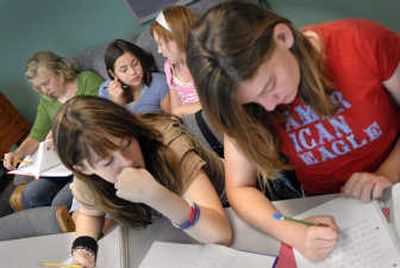Math methods prove divisive

Hours before the start of the school day Friday in the basement of a northwest Spokane church, Emily Stone looked carefully over her completed worksheet of fractions and decimals.
“This is a test to show what I know already,” the 12-year-old said.
But the test wasn’t part of any assignment at Salk Middle School, where Stone is a seventh-grader. The pre-algebra lessons are part of “underground” math classes being offered before school this year at Prince of Peace Lutheran Church – about three miles from the Spokane school.
Parents pay $100 for the twice-a-week “traditional” math courses given by area teachers, who are paid a small stipend. Instead of using reform math adopted by the district, called Connected Math, the parents are using “back-to-basics” Saxon Math curriculum.
The parents had wanted to use school space for the classes, but Spokane Public Schools denied access. That’s also happening in the Central Valley School District and across the state, as parents seek to use the school buildings in order to provide an alternative to district-adopted curriculum.
“They told me that if I did not teach their curriculum, I was not going to teach anything” in school buildings, said Andrew Holguin, a CV parent who has organized “underground” math courses using space at Gonzaga University. Holguin, who also chairs the district’s Native American program, wanted to use a traditional math program called Singapore Math to help struggling students.
“If the students aren’t grasping mathematics, what is the harm in teaching them basic math?” Holguin said.
It’s the latest development in the “math wars” – a battle being played out around the country as districts look to boost test scores and bring students to “standard” in the wake of federal mandates like the No Child Left Behind Act. Under the federal law, every child is expected to be proficient in math by 2014, measured in this state by the Washington Assessment of Student Learning.
As states struggle to get kids to that goal – about half of Washington’s 10th-graders continue to fail the math portion of the WASL – districts have adopted what is known as reform mathematics. The new math programs emphasize problem-solving and critical thinking applied to everyday situations – and patterned after questions that appear on the WASL tests. The curriculum replaces traditional math courses such as algebra, geometry and trigonometry.
Parents opposing the new math call it “fuzzy,” complaining about the lack of focus on basic computation skills and rote memorization of facts. The new math emphasizes exploration and explanation, in which a student is required to explain in writing how she arrived at a particular answer.
“Simply memorizing something doesn’t have much meaning,” said Karin Short, executive director of instructional programs for Spokane Public Schools.
The district curriculum not only provides math fluency, but applies math concepts to problem-solving skills needed in the real world, Short said.
“Learning by definition is a change of behavior; that’s what we are looking for,” Short said. “If you can’t use it, it’s kind of a waste of time.”
But some parents believe the curriculum itself does not provide a foundation for success, especially for students wanting to pursue mathematics-related degrees in college.
Short pointed to a new Math-Science Partnership Initiative, formed this year in an effort to align curricula among high schools, community colleges and university classrooms so students need fewer remedial math courses in college.
“I still see holes in (Connected Math) and I wanted to supplement that,” said Laura Lunnen, who has two children at Salk and who helped organize the alternate math classes for students. “I never went into it anticipating the politics.”
Lunnen said she was originally told by Salk Principal Mark Gorman that the parents could use a classroom at the school. But district administrators would not allow that unless the parents were willing to teach the district-approved curriculum.
The parents were told they could instead pay to use the building – about $77 per day.
At Central Valley, Holguin encountered the same resistance. He was told by Bowdish Middle School Principal Dave Bouge that arrangements could be made to use the building, but once district officials learned that students would be taught using a different curriculum, they said no.
“When we provide extended day services of any sort, we really want it to be an extension of the school day in terms of the alignment of curriculum,” said Terrie VanderWegen, executive director for teaching and learning for CV. “If students do need tutoring; they need to have tutoring in the curriculum they are having problems in.”
Some parents argue that the Saxon and Singapore Math curricula have histories of success. Saxon was adopted last year as a supplement to Tacoma Public Schools’ curriculum. In the 29,000-student district, which rivals Spokane in size, math scores on the WASL were up across the board this year for third through eighth grades, as well as 10th-graders. Parents say they simply want the choice for their children.
“There’s four foreign languages offered at the high school and only one math,” said Jim Harrison, a sixth-grade teacher at Balboa Elementary School who was hired to teach the “underground” math classes in Spokane. “Why isn’t there four math choices and one foreign language?”
Harrison said he fears Spokane is losing top students to other districts like Mead, which offers both traditional and reform math to students. Some families are also choosing to home school their children in math, he said.
“Let’s give the parent, the person that pays the taxes, the choice and not resign them to, ‘This is it; take it, or get out,’ ” Harrison said.